As the Grand Prix series concludes prior to the Final, the establishment of a field in the absence of the world-leading dance teams of the previous quad has begun to emerge. To that end, a review of the development, from last season through most recent international competitions, of PCS as assigned to those senior American and Canadian dance teams more prominent on the scene (scores include only senior events and selected international Bs/Challenger Series competitions):
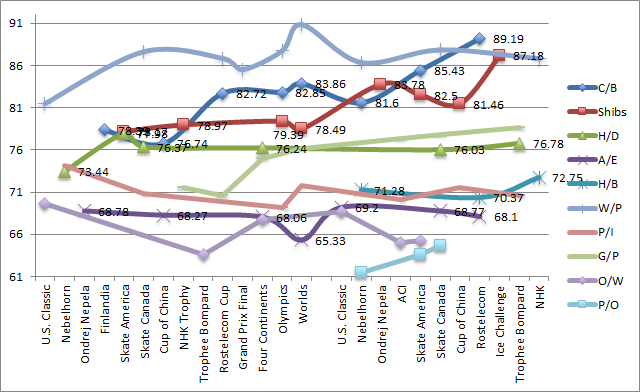
C/B = Chock/Bates | Shibs = Shibutani/Shibutani | H/D = Hubbell/Donohue | A/E = Aldridge/Eaton | H/B = Hawayek/Baker | W/P = Weaver/Poje | P/I = Paul/Islam | G/P = Gilles/Poirier | O/W = Orford/Williams | P/O = Paradis/Ouellette
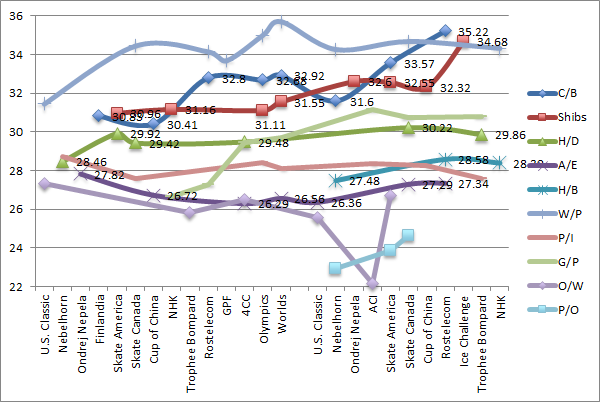
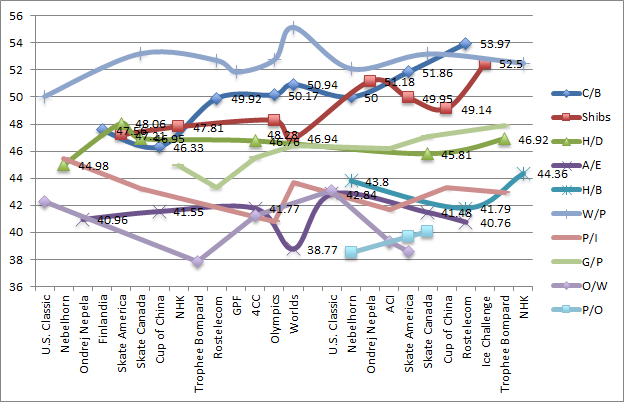
Scores for Madison Chock & Evan Bates and Kaitlyn Weaver & Andrew Poje did see an uptick with the World Championships at which each couple appeared as national leaders — a phenomenon first discussed in our first series entry — but the trend’s continuation into this first post-Olympic season is inconsistent. Outside of North America, one key additional example of this phenomenon can be offered. With the retirements of France’s previous leading senior teams Nathalie Pechalat & Fabian Bourzat and Pernelle Carron & Lloyd Jones, Gabriella Papadakis & Guillaume Cizeron — who entered the senior circuit in 2013 — now find themselves on mostly solitary turf. After a series of disappointing results in that first season, they have this year won three internationals — Skate Canada Autumn Classic International, Cup of China and Trophée Eric Bompard. Their marks in accordance with the journey provide an interesting illustration:
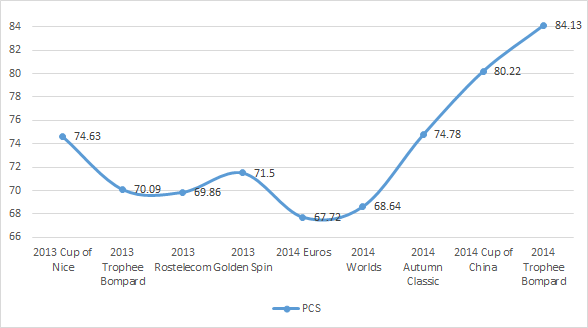
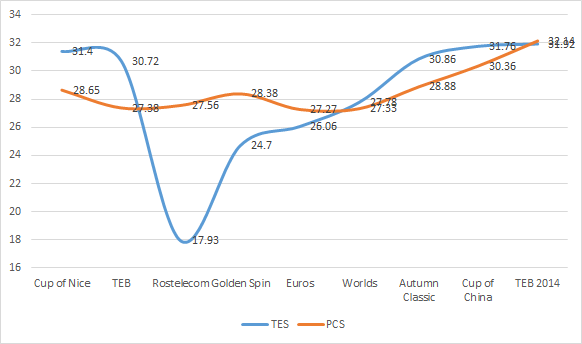
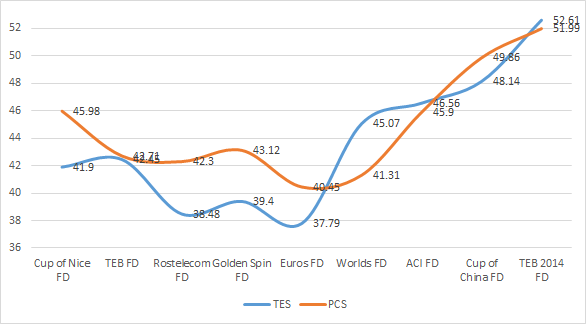
Within North America, the absence of Meryl Davis & Charlie White may have meant a boost for two American couples, as both leading U.S. Worlds finishers Chock & Bates and 2011 World bronze medalists (and 2012-13 and 2013-14 U.S. #3) Maia & Alex Shibutani have seen skyrocketing numbers — a particularly interesting development for the latter, who saw no sustained growth after their World medal (79.51 total PCS) through the 2013-14 season (78.49 total at Worlds). As Canadian leaders, however, Weaver & Poje have seen a numbers decline from that Worlds silver high; their current marks are on par with or slightly lower than those received on last season’s Grand Prix circuit.
Among the secondary and tertiary couples, instability is the only true constant. For Detroit Skating Club training mates Madison Hubbell & Zach Donohue (#4 at 2013 and 2014 U.S. Nationals; 2014 Four Continents champions) and Alexandra Paul & Mitch Islam (2014 Canadian bronze medalists and tenth at 2014 Worlds), marks have remained strikingly consistent through one-and-a-half seasons; with a high and low outlier for each removed, range has been limited to 0.75 for Hubbell & Donohue and 1.7 for Paul & Islam, with neither team seeing a regular upward or downward trend. Meanwhile, a trend for their youngest peers, 2014 World Junior champions Kaitlin Hawayek & Jean-Luc Baker, is so far rather difficult to discern — though the impact of a Grand Prix bronze in their first senior circuit is yet to be determined. And despite a training move from the Detroit Skating Club to Canton’s Arctic Edge, Americans Alexandra Aldridge & Daniel Eaton (#5 at 2014 U.S. Nationals; bronze at 2014 Four Continents) too have observed little change.
Two other Canadian medalist teams have seen vastly divergent fortunes. After two lower-scoring outings on the 2013 Grand Prix and a fourth-place finish at 2014 Nationals, Piper Gilles & Paul Poirier’s PCS expanded by about 4 points in a second-place finish at 2014 Four Continents and from there has grown by the outing by an average of 0.92 points, with the largest jump of 1.21 from Worlds to Autumn Classic International. For Nicole Orford & Thomas Williams (bronze at 2013 Nationals and fifth at 2014’s event), their greatest PCS range over two seasons is 5.97, with both high and low coming at consecutive 2013-14 outings. However, while a 68.64 at this season’s opening U.S. International Figure Skating Classic was the team’s second-best total, the number dropped by 3.58 in a clean follow-up at Autumn Classic International — a lower total than came in their season Grand Prix outing at Skate America, which included a costly fall for Williams.
Training mates to Papadakis & Cizeron at Gadbois in Montreal, Canadians Elisabeth Paradis & Francois-Xavier Ouellette previously competed only once internationally, at last season’s Cup of Nice, where they finished fifth. Like the French couple, the team has seen a similar upwards trend in a short competitive span this season, with a growth rate averaging 1.64 points per event.
As a reminder, the five Program Components categories carry with them not only specific definitions, but requirements to which each range of marks is to be accorded, as detailed on page 27 of Communication 1860.
